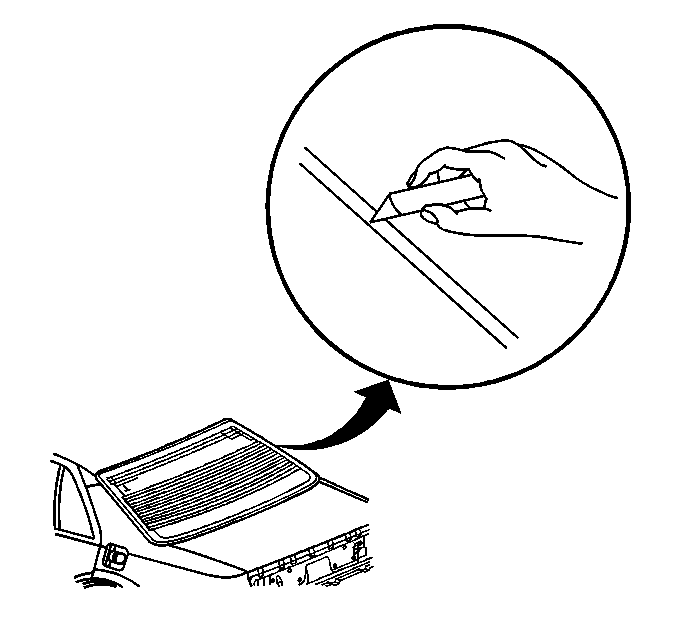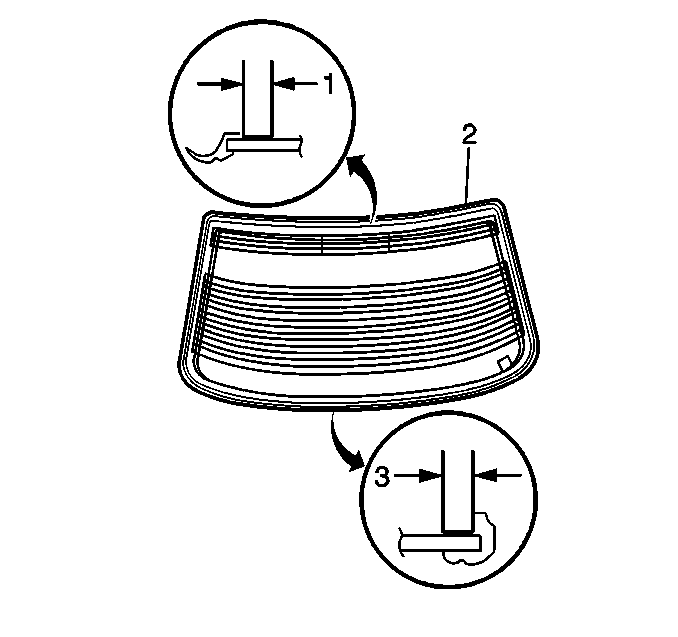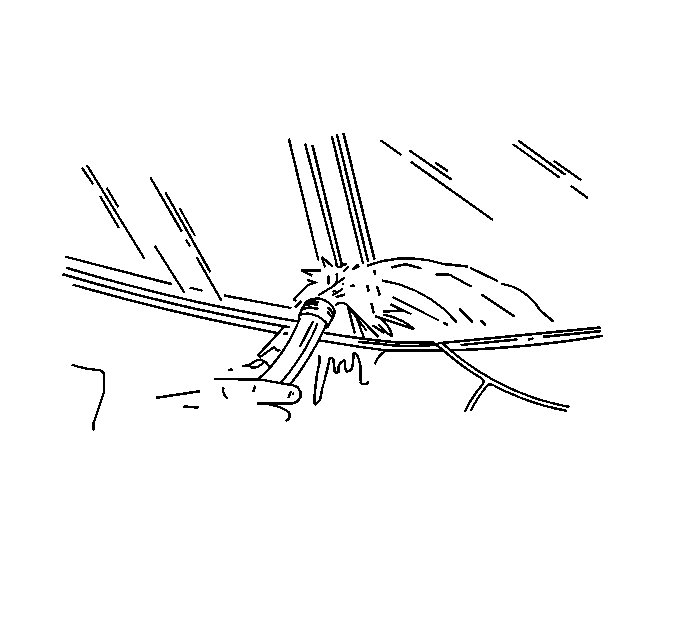Removal Procedure
Caution: When replacing stationary windows, urethane kit GM P/N 12346284 or equivalent
must be used to maintain original installation integrity. Failure to use the
urethane kit will result in poor retention of the windshield which may allow
unrestrained occupants to be ejected from the vehicle resulting in personal
injury.
Caution: When you are working with any type of glass, use approved safety glasses
and gloves to reduce the chance of personal injury.
Tools Required

- Remove the rear window
lower reveal molding.
- If the rear window can not be reused, cut the outer lip of the
rear window reveal molding off with a urethane razor knife or equivalent to
allow access to the body pinchweld.
Important: The rear window is an encapsulated window. The reveal molding is molded
to the rear window surface an can NOT be reused if damaged. The rear window
must be replaced when a new reveal molding is needed.
- Remove the sail panels. Refer to
Sail Panel Replacement
in Interior Trim.
- Disconnect the electrical connectors from the rear window.
- Mask off the area around the windshield to protect the painted
surface.
- Working out side the vehicle, cut out the windshield using a J 24402-A
.
- Remove the window with the aid of a helper and the suction cups
from the J 36863
.
- Remove all of the urethane from the body pinchweld using a sharp
scraping tool.
- Remove all of the urethane from the rear window using a sharp
scraping tool.
Cleaning Procedure
- Clean all loose urethane and debris using a vacuum.
- Wipe the body pinchweld flange with a clean dry cloth.
Important: Ensure that the window opening is properly prepared before window installation.
- If there is corrosion on the pinchweld or if sheet metal repairs
or replacements are required, the pinchweld flange must be refinished to present
a PRIMER ONLY surface.
- If paint repairs are required, mask the flange bonding area (prior
to applying the color coat) to provide a PRIMER ONLY surface.
- The appropriate materials for these primer applications are typically
two component, catalyzed products such as BASF DE 17, DUPONT 2610, PPG DP90
(or equivalent) applied by following the manufactures directions for
mix, application and drying times.
- After repairing the window opening as indicated, shake the pinchweld
primer #3 (black) well, and using a new dauber, apply the primer to the bonding
area of the pinchweld. Allow to dry for 10 minutes.
Installation Procedure
- Dry fit the window into the body opening to determine the correct
position by:
| • | Positioning the window into the opening. |
| • | Using masking tape, mark the location of the window into the opening
on at least one horizontal edge and one vertical edge of the window. |
| • | Slit the masking tape at the window edges and remove the window
from the body opening. |
| • | Place the rear window on a clean protected work surface with the
inside of the window facing up. |
- Prepare the rear window for installation.
Important: The application of primers is important as they act as the agent that
will bond the urethane to the rear window. Be sure to use the specified primer
for each application listed below for proper adhesion.
- Shake the pinchweld primer #3 (black) well and apply it to any
exposed painted surfaces (or scratches to any bare metal) on the body pinchweld
flange. Allow to dry for 10 minutes.
Important: Care should be taken to prevent the glass prep #1 (clear) from running
into the vision area of the window. This primer dries almost instantly, but
may stain the viewing area of the window if not applied evenly.

- Using a new dauber, apply
the glass prep #1 (clear) around the entire perimeter of the inner surface
and any exposed edges of the window. Wipe the surface dry with a clean
cloth.

- Shake the primer #2 (black)
well and using a new dauber apply the primer around the edges of the windshield (2),
13 mm (½ in) inboard on the inner surface, over the same
area that the glass prep #1 (clear) was applied.
- Allow the primer to dry for 10 minutes.

- Install a tube of urethane
in the J 24811
.

- Apply the urethane adhesive
to the windshield.
- Apply a bead (1) 8 mm (5/6 in) height (6) and 14 mm
(9/16 in) wide (5).
- With the aid of a helper and the suction cups from the J 36863
install the rear glass. Apply pressure
to wet-out and set the adhesive.
- Tape the rear window at the top using four pieces of tape.
- Watertest the rear window immediately using a soft spray. Warm
or hot water is preferred to accelerate the curing of the adhesive. DO NOT
direct a hard stream of high pressure water at the fresh urethane adhesive.
Refer to
Water Hose Test
in General Information.

- If a leak is detected,
apply urethane adhesive to the leak point and 127 mm (5 in) on both
sides of the leak point using a flat bladed tool.
Important: The following steps must be taken before competing the installation
procedure.
| • | Allow the vehicle to remain at room temperature 22°C (72°F)
at 30% relative humidity for a minimum of 6 hours. |
| • | Lower the door windows partially to prevent pressure build up
when closing the doors prior to the urethane adhesive curing. |
| • | DO NOT DRIVE THE VEHICLE until the urethane is cured a (minimum
6 hours at room temperature). |
| • | DO NOT USE COMPRESSED AIR to dry the urethane adhesive. |
- Remove the masking tape from the rear window after the urethane
has cured.
- Connect the electrical connectors to the rear window.
- Install the sail panels. Refer to
Sail Panel Replacement
in Interior Trim.






